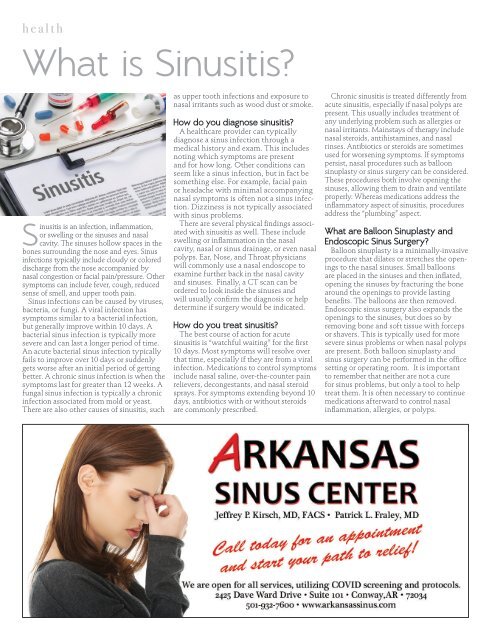Faulkner Lifestyle Aug/Sept 2020
- TAGS
- southern-savvy
- harwell-designs
- bank-of-the-ozarks
- dr-michael-cooper
- centennial-bank
- first-security-bank
- first-community-bank
- conway-remodeling-and-more
- conway-institute-of-music
- tucker-creek-vet
- hydrafacial
- studio-skin
- strain-photography
- spud-love
- grab-n-go-smoked-meats
- ygbfk
- faulkner-county
- conway
Create successful ePaper yourself
Turn your PDF publications into a flip-book with our unique Google optimized e-Paper software.
health<br />
What is Sinusitis?<br />
Sinusitis is an infection, inflammation,<br />
or swelling or the sinuses and nasal<br />
cavity. The sinuses hollow spaces in the<br />
bones surrounding the nose and eyes. Sinus<br />
infections typically include cloudy or colored<br />
discharge from the nose accompanied by<br />
nasal congestion or facial pain/pressure. Other<br />
symptoms can include fever, cough, reduced<br />
sense of smell, and upper tooth pain.<br />
Sinus infections can be caused by viruses,<br />
bacteria, or fungi. A viral infection has<br />
symptoms similar to a bacterial infection,<br />
but generally improve within 10 days. A<br />
bacterial sinus infection is typically more<br />
severe and can last a longer period of time.<br />
An acute bacterial sinus infection typically<br />
fails to improve over 10 days or suddenly<br />
gets worse after an initial period of getting<br />
better. A chronic sinus infection is when the<br />
symptoms last for greater than 12 weeks. A<br />
fungal sinus infection is typically a chronic<br />
infection associated from mold or yeast.<br />
There are also other causes of sinusitis, such<br />
as upper tooth infections and exposure to<br />
nasal irritants such as wood dust or smoke.<br />
How do you diagnose sinusitis?<br />
A healthcare provider can typically<br />
diagnose a sinus infection through a<br />
medical history and exam. This includes<br />
noting which symptoms are present<br />
and for how long. Other conditions can<br />
seem like a sinus infection, but in fact be<br />
something else. For example, facial pain<br />
or headache with minimal accompanying<br />
nasal symptoms is often not a sinus infection.<br />
Dizziness is not typically associated<br />
with sinus problems.<br />
There are several physical findings associated<br />
with sinusitis as well. These include<br />
swelling or inflammation in the nasal<br />
cavity, nasal or sinus drainage, or even nasal<br />
polyps. Ear, Nose, and Throat physicians<br />
will commonly use a nasal endoscope to<br />
examine further back in the nasal cavity<br />
and sinuses. Finally, a CT scan can be<br />
ordered to look inside the sinuses and<br />
will usually confirm the diagnosis or help<br />
determine if surgery would be indicated.<br />
How do you treat sinusitis?<br />
The best course of action for acute<br />
sinusitis is “watchful waiting” for the first<br />
10 days. Most symptoms will resolve over<br />
that time, especially if they are from a viral<br />
infection. Medications to control symptoms<br />
include nasal saline, over-the-counter pain<br />
relievers, decongestants, and nasal steroid<br />
sprays. For symptoms extending beyond 10<br />
days, antibiotics with or without steroids<br />
are commonly prescribed.<br />
Chronic sinusitis is treated differently from<br />
acute sinusitis, especially if nasal polyps are<br />
present. This usually includes treatment of<br />
any underlying problem such as allergies or<br />
nasal irritants. Mainstays of therapy include<br />
nasal steroids, antihistamines, and nasal<br />
rinses. Antibiotics or steroids are sometimes<br />
used for worsening symptoms. If symptoms<br />
persist, nasal procedures such as balloon<br />
sinuplasty or sinus surgery can be considered.<br />
These procedures both involve opening the<br />
sinuses, allowing them to drain and ventilate<br />
properly. Whereas medications address the<br />
inflammatory aspect of sinusitis, procedures<br />
address the “plumbing” aspect.<br />
What are Balloon Sinuplasty and<br />
Endoscopic Sinus Surgery?<br />
Balloon sinuplasty is a minimally-invasive<br />
procedure that dilates or stretches the openings<br />
to the nasal sinuses. Small balloons<br />
are placed in the sinuses and then inflated,<br />
opening the sinuses by fracturing the bone<br />
around the openings to provide lasting<br />
benefits. The balloons are then removed.<br />
Endoscopic sinus surgery also expands the<br />
openings to the sinuses, but does so by<br />
removing bone and soft tissue with forceps<br />
or shavers. This is typically used for more<br />
severe sinus problems or when nasal polyps<br />
are present. Both balloon sinuplasty and<br />
sinus surgery can be performed in the office<br />
setting or operating room. It is important<br />
to remember that neither are not a cure<br />
for sinus problems, but only a tool to help<br />
treat them. It is often necessary to continue<br />
medications afterward to control nasal<br />
inflammation, allergies, or polyps.<br />
faulknerlifestyle.com 33
















